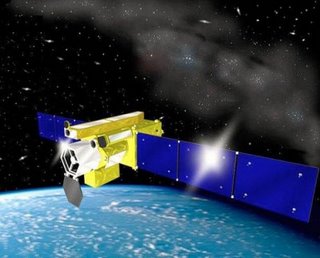
 Orbiter to Look for Lost-To-Mars Probes - Yahoo! News
Orbiter to Look for Lost-To-Mars Probes - Yahoo! NewsAs noted in earlier posts, the Mars Reconnaissance Orbiter (
MRO) has entered its working orbit after a long series of
aerobraking maneuvers that placed it in its working orbit around Mars. One of it's cameras may help find previous spacecraft that failed to call home. (
Mars Polar Lander ,
Beagle 2) MRO will also look for potential landing sites for future unmanned and manned missions.
In other Mars news, the two vehicles exploring the surface of Mars (
Spirit, Opportunity) are years beyond their life expectancy and still working. They are about to start their second Mars Spring. One, Opportunity, will explore the Victoria Crater (picture taken with the
MRO Hi-Rise Camera). See also
Google Mars.
In news that won't mean much to anyone not on the U.S. West Coast or somewhere in the middle of oceans, the planet Mercury will soon transit the sun. Telescopes will be set up at
OMSI in Portland to watch this event, weather permitting.
Finally, SETI is still in business. Originally, the radio telescopes were tuned to the
wavelength of hydrogen gas with the belief that any civilization would choose the frequency most likely to penetrate the fog of space. However, over time and distance, this frequency shifts. The next generation of radio telescopes will be better able to take this into account in the search for intelligent signals from other civilizations. If you wish to donate computer time to this search, go to
SETI @ Home.The U.C. Berkeley computer geeks hosting this program also run a system known as Berkeley Open Infrastructure for Network Computing (
BOINC). Here, you can volunteer your computer time to SETI, math, biology, medicine, astronomy, physics or earth sciences. I've been a SETI @ Home participant for a number of years. However, to my knowledge, I have yet to analyze a "
WOW" signal.
Well, that is all for today folks. Keep those Pink Flamingos in your yards!












